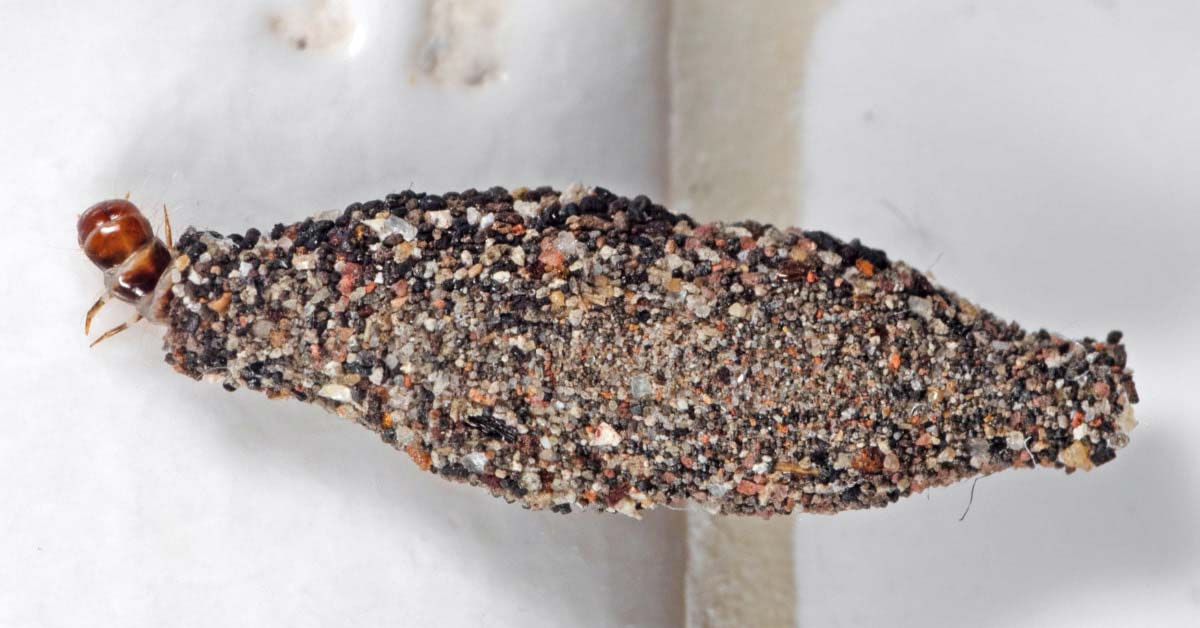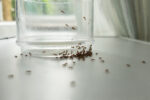
The Household Casebearer: Plaster Bagworms
The Household Casebearer, also known as the plaster bagworm, is a type of moth that is prevalent throughout South Florida. However, this moth insect is most known for its juvenile caterpillar life stage where is resembles a worm-like insect hiding and protected within a flat, grey case. The caterpillar uses its silk glands to manufacture this case from silk, and hardens the exterior by collecting and adding small particles of sand, fibrous debris, insect remains, etc. The caterpillar carries the case while it feeds, using it for protection, and once it is developmentally ready, the caterpillar will eventually use it as a pupal case to undergo its transformation into an adult moth. The Household Casebearer requires high humidity to reproduce and complete its lifecycle, making the tropical environment of the Sunshine State the perfect place for this bug to make its home. Hulett Environmental Services, a local pest control company in South Florida for over 50 years, knows about this insect all-too-well.
The life stage of this insect that is normally discovered within the home is the larval stage, or the worm-like caterpillar. This caterpillar can be a pest of household items, as it enjoys eating wool and silk, but it will also consume hair fibers, lint, household debris, spider webs, and dead insects. It has even been known to eat the cases of other dead Household Casebearers. As the live caterpillar continues to feed, it and its case continue to grow. It is often the case that is first found by the homeowner, often on the floor or walls of the rooms in the home that have high humidity; namely baths, garages, closets, and kitchens. However, in severe infestations, these can also be found all over the outside of homes too.
Once the caterpillar is developmentally ready to transform into an adult, it will pupate within its casing and emerge as a winged moth. This is why sometimes the cases that are discovered within the home are empty, and sometimes they still contain the worm-like caterpillar. The casing of a fully developed larva can be as long at 14 mm and wide as 5 mm.
If an infestation is severe, you may even see the grey-patterned moths flying around the infested area. The adults will mate, and the females will lay up to 200 eggs, adhering them to debris located in cracks and crevices. The emerging larvae can use this debris as food. Because of this cyclical pattern and high reproductive rate, Infestations can become severe if left untreated.
Due to the unsightly appearance and annoyance of having these insects present in your kitchen and bath, professional pest control is recommended. A pest control expert will be able to discuss with you the various conditions that are present that are allowing for infestation, and show you techniques to remove those conducive conditions. Additionally, a professional treatment should be completed to help knockdown the infesting population, and treat the areas that the caterpillars are likely to traverse or harbor, for residual control.
How to Prevent Household Casebearers in Your Home
Unfortunately, there are many items in your home that may attract Household Casebearers, and it can be challenging to prevent them because there is an abundant amount of food sources your home has to offer. However, there are techniques a homeowner can use to decrease the pressure by the Household Casebearer.
Because these caterpillars feed on spider webs, household debris including hair and fur, and use sand and insect parts to attach to its casing, frequent cleaning and vacuuming practices can help decrease potential food or nesting resources. Because these insects require a high moisture content, increasing the airflow and decreasing humidity by running fans or the air conditioner can create an environment less suitable for the insect. Homeowners can also utilize moisture absorbers to help remove humidity from a room or area.
Oftentimes, completing these suggestions alone may reduce the presence of Household Casebearer, but may not completely eradicate the issue. The best control will occur by completing these suggestions alongside recurring treatments into the cracks and crevices and places of harborage by a professional pest control company. With routine maintenance, a trained pest control operator will be onsite, and be able to identify these problems and treat accordingly, before a large infestation begins.
Ask Our Experts
If you believe that your home or property may have a problem with Household Casebearers, or any other pest problem, contact Hulett Environmental Services today. We will schedule a free, no-obligation home inspection where a bug expert will visit your property to evaluate any signs of activity. After the free inspection, our experts will provide you with the best course of action for treatment. If you prefer, you can also give our team a call!



